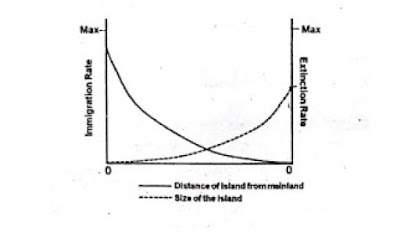CSIR TOP QUESTION IN JUNE EXAM WITH FULLY EXPLANATION
Question 1
The above graph illustrates two
lines that represent the immigration and extinction rates for an island based
on its distance from mainland (solid line) and its size (dotted line). Which of
the following is true for this island?
1. It is close to the mainland and
is very small
2. It is far from the mainland and
is very large
3. It is close to the mainland and
is very large
4. It is far from the mainland and
is very small.
Answer: 3
Explanation: Closer
and larger island have higher immigration rate and lower extinction rate.
Arriving colonists help sustain the presence of a species on a near island and
prevent its extinction. Hence if you observe the graph the equilibrium point is
reached, it has higher immigration rate as compared to extinction rate.
Therefore option 3 is correct.
Question 2
The following figure is a
“risk-graph” that illustrates the percentrisk a species faces towards
extinction. The following are ranks assigned according to IUCN’s red list
category:
(i) Critically endangered
(ii) Near threatened
(iii) Vulnerable
(iv) Least concern
Which one of the following is the
most appropriate match between the percent-risk and their assigned rank?
1. a - (i), b - (iii), c - (iv), d
- (ii)
2. a - (i), b - (iv), c - (iii), d
- (ii)
3. a - (iii), b - (ii), c - (i), d
- (iv)
4. a - (iv), b - (iii), c - (ii),
d - (i)
Question 3
Following table contains some of
the generalizations of evolutionary biology:
Which of the following is correct match between Column I and Column II
1. A - (i), B - (ii), C - (iv), D
- (iii)
2. A - (i), B - (iii), C - (iv), D
- (ii)
3. A - (ii), B - (iii), C - (i), D
- (iv)
4. A - (iv), B - (iii), C - (i), D
- (ii)
Answer: 2
Explanation: Cope’s rule states
that animal population lineages tend to increase in body size over evolutionary
time.
Dollo’s law of irreversibility,
states that “an organism never returns exactly to a former state, even if it
finds itself placed in conditions of existence identical to those in which it
has previously lived ... it always keeps some trace of the intermediate stages
through which it has passed.
Van Valen’s law
states that the probability of extinction for species and higher taxa (such as
families and orders) is constant for each group over time; groups grow neither
more resistant nor more vulnerable to extinction, however old their lineage is.
Occam’s razor (or Ockham’s razor) is
a principle from philosophy and science. Suppose there exist two explanations
for an occurrence. In this case the simpler one is usually better- also called
the Principle of Parsimony.
Question 4
Given below are certain statements
regarding plant-pathogen interactions:
A. The pattern recognition
receptor (PRR), upon perceiving pathogen or microbe-associated patterns
(PAMPs/MAMPs), activates plant defences resulting in pattern triggered immunity
(PTI)
B. A vrPto is a resistance gene in
tomato that acts against pathogenic attack by the bacterium Pseudomonas
syringae pv. Tomato.
C. The effector molecules produced
by pathogen is recognized by resistance ( R ) gene present in plants resulting
into a defence strategy known as effector triggered immunity (ETI)
D. Defence mechanisms triggered in
plants during PTI are usually stronger than those during ETI
Which one of the following
combinations of above statements is correct?
1. A and B
2. C and D
3. A and C
4. B and D
Answer: 3
Explanation: The
first interaction between the plants and microbes take place in apoplast and is
mediated by the recognition of microbial elicitors by the receptor proteins of
the plants. These microbial elicitors, also known as pathogen-associated
molecular patterns (PAMPs), are recognized by the membrane- localized pattern
recognition receptors (PRRs) of plants. The bacterial flagellin and elongation
factor (EF)-Tu peptide surrogates, flg22 and elf18, and chitin, are common
examples of PAMPs, which are recognized by the plant PRRs that include the
three receptor-like kinases, flagellin-sensitive22 (FLS2), EF-Tu receptor
(EFR), and chitin elicitor receptor kinase1 (CERK1). The successful recognition
of microbial derived PAMPs by PRRs of the plants activates a first line of
defense which is known as PAMP-triggered immunity (PTI).So A is correct.
However,
resistance (R) proteins of plants recognize these effector proteins of
pathogens and can induce a second line of defense which is known as the
effector- triggered immunity (ETI) . ETI is quantitatively stronger and faster
than PTI and can result in a localized cell death (hypersensitive response) to
kill both pathogen and pathogen infected plant cells. C is correct and D is
wrong. The avrPto gene of Pseudomonas syringae pv tomato triggers race-specific
resistance in tomato plants carrying Pto, a resistance gene encoding a protein
kinase. When introduced into P. s. tabaci, avrPto triggers resistance in
tobacco W38 plants that carry the corresponding R gene. The AvrPto protein is
believed to be secreted into host cells through the bacterial type III
secretion pathway, where it activates disease resistance in tomato by
interacting with Pto.So the AvrPto gene is from the bacteria not from the
plant. So B is also wrong. So correct combination should be A and C.






Comments
Post a Comment
Thanks for Comment....